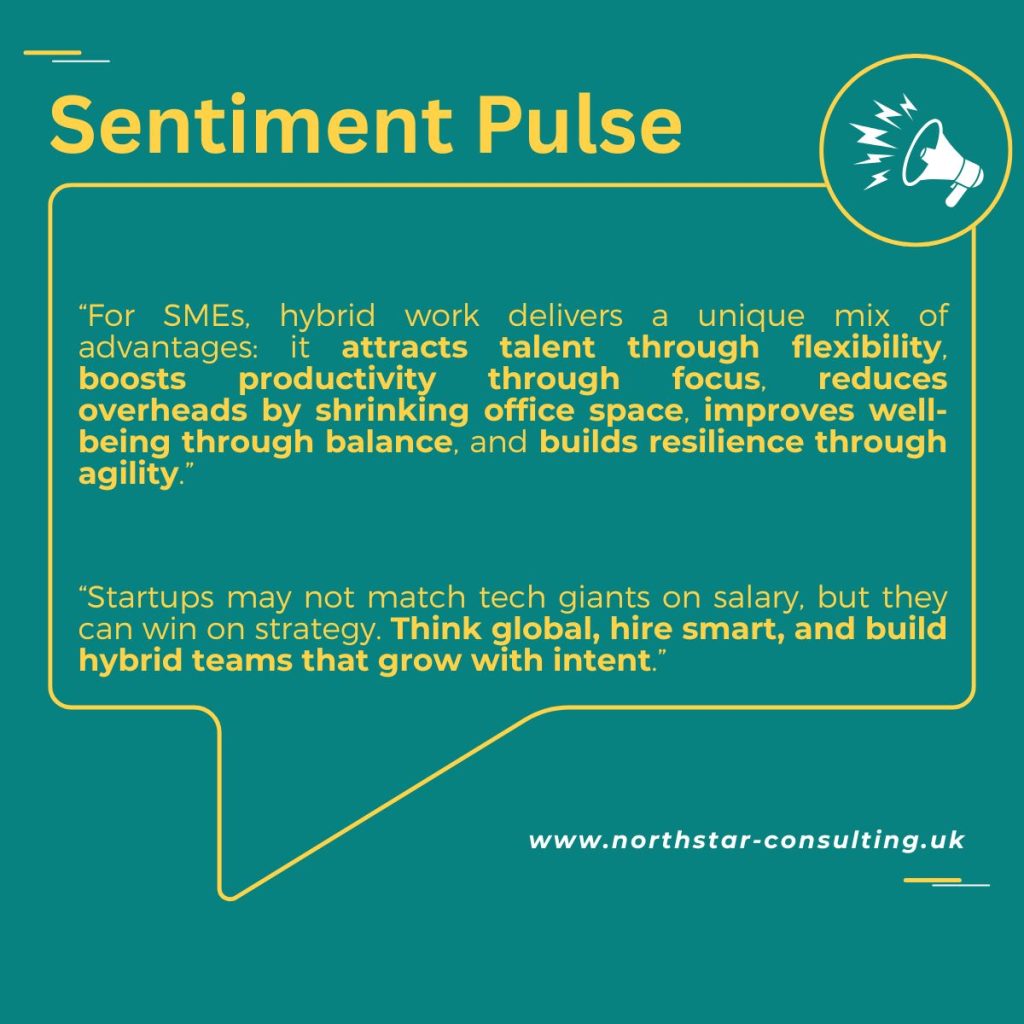“Remote-first” is no longer an experiment. It is a deliberate growth strategy reshaping how modern businesses scale. For SMEs, it opens access to global talent, lowers fixed costs, and accelerates entry into new markets.
It is important to distinguish between remote-first and hybrid work. Hybrid models balance time between home and office, while remote-first takes this further by designing culture, processes, and leadership around digital collaboration from the outset. Hybrid was the bridge, and remote-first is the destination.
For SMEs, this evolution is transformative. It combines the reach of a global firm with the agility of a start-up. It replaces geography with capability and management by presence with management by trust. Studies show that remote-friendly and hybrid roles now attract significantly more applicants, while employers adopting these models can save 20–30% on overheads once rent, travel, and utilities are removed. For growth-stage SMEs, that margin can determine whether they scale or stall.
The Business Case for Remote-First: Scale, People and Performance
Remote-first and hybrid work are not about convenience. They are about competitiveness. For SMEs, they unlock business agility, allowing them to hire across borders, operate leaner, and attract talent once reserved for multinationals. Firms that design remote-first systems intentionally gain enduring advantages in recruitment, innovation, and resilience.
Scaling Through Access and Efficiency
Remote-first radically expands the hiring horizon. Remote roles attract outsized applicant interest. In September 2025, about 8% of LinkedIn postings were remote, yet they drew 35% of applications, and remote-first firms reported surges in candidate volume. Smaller companies advertising “no RTO required” are successfully poaching talent from bigger brands, and flexibility is often perceived by candidates as worth about an 8% pay rise.
The financial argument is equally persuasive. Analyses across 2024 and 2025 show 20–30% employer savings from remote or hybrid arrangements when office, utilities, and travel are removed. Global Workplace Analytics estimates employers save around £8,000 per person per year for half-time remote work. Many SMEs redirect these savings into wellbeing and technology, turning efficiency into engagement.
Building Connected Cultures in Remote-First Teams
The success of remote-first teams depends as much on culture as it does on technology. Without deliberate design, the distance that enables flexibility can easily create fragmentation. SMEs that thrive in remote-first settings counter this by designing culture into their operations. Structured onboarding, mentoring systems, and quarterly gatherings replace corridor conversations, while AI-enabled collaboration tools ensure knowledge and creativity travel seamlessly across time zones. In 2025, 64% of companies said they encourage AI use at work, and 80% of employees reported using it daily to stay productive and connected.
Remote-first leadership requires a different mindset. Managers can no longer rely on physical visibility to gauge engagement or performance. The most effective leaders manage through trust and shared outcomes, focusing on enablement rather than oversight. Harvard Business Review found that distributed leadership succeeds when it empowers teams with autonomy and clarity rather than control.
Sustaining well-being is equally vital. Around a third of remote workers report interruptions and blurred boundaries as barriers to productivity. High-performing SMEs address this by building “designed discipline” into the workday through meeting-free days, focus-time blocks, and wellness stipends that help employees maintain balance. Research by Insightful reports that 54% of employers said remote work increased productivity, and 40% of employees said remote arrangements helped them concentrate better compared with the office.
Behind this cultural architecture lies the digital backbone that makes remote-first sustainable. Distributed endpoints expand the attack surface, so zero-trust frameworks, multi-factor authentication, and managed IT support have become essential for SMEs to safeguard data and continuity. When culture, trust, and secure technology work in concert, remote-first organisations can scale their reach and performance without losing cohesion or confidence.

Case in Point: SMEs Winning with Remote-First
Buffer, a social media management platform, has operated fully remotely since 2013, helping businesses schedule and analyse their content across multiple channels. What sets Buffer apart is how it has built remote-first principles into its core operations rather than treating them as a convenience. The company publishes its annual State of Remote Work reports, using insights from its own workforce to refine culture and policy. Its transparency, covering pay structures, decision-making, and performance, has become central to its employer brand. For SMEs, Buffer proves that remote-first can be a growth strategy in itself, turning openness and trust into enduring competitive strengths.
PaidHR, a Nigerian HR-tech startup, was founded to simplify payroll and compliance for businesses managing distributed teams across Africa. Built on a remote-first model from day one, the company used its own experience of coordinating a global workforce to shape its product design.
Its platform enables SMEs to manage cross-border hiring with ease, turning an internal challenge into a commercial opportunity. In 2025, PaidHR raised £1.3 million in seed funding to expand these services. For smaller firms, PaidHR shows how remote-first can evolve from an operational necessity into a scalable business model that empowers others to do the same.
Remote-First as a Growth Engine
Remote-first is not a workplace policy. It is a blueprint for SME growth. What began as a necessity has become a model for agility, creativity, and sustainability. Where expansion once meant leases and local hiring, remote-first now allows SMEs to operate borderlessly, recruit globally, and reinvest directly in innovation.
The most forward-thinking SMEs treat remote-first as infrastructure, not ideology. They manage by trust, design culture intentionally, and secure their operations as they scale. They understand that flexibility is now the currency of loyalty and that agility, once a survival skill, has become a competitive advantage.
For leaders, the message is clear. Remote-first is not about location. It is about leverage. It converts fixed costs into variable potential, local teams into global networks, and management into a catalyst for creativity. Hybrid opened the door to flexibility, while remote-first builds the house around it. The SMEs that choose to live there will define the next era of business agility.
👉 For sharper insights on the future of work, leadership, and SME strategy, follow NorthStar and The Pulse – your guide to building agile, connected, and globally competitive businesses.
This is an updated version of this article.




